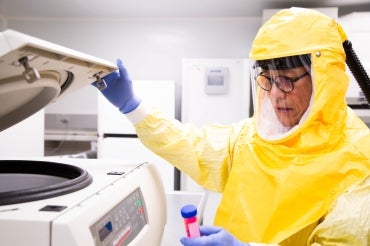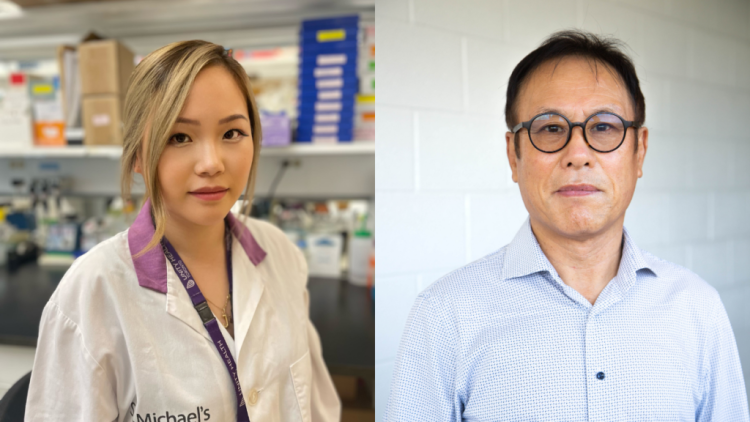Research may explain why men are more likely to experience severe cases of COVID-19

Haibo Zhang, a researcher at Unity Health Toronto and U of T, led pre-clinical research that suggests why males are more likely to experience worse outcomes from COVID-19, opening the door to potential new treatments (photo by Julia Soudat)
Published: October 3, 2023
A new study by a team of researchers at the University of Toronto’s Emerging and Pandemic Infections Consortium (EPIC) has uncovered biological reasons underlying sex differences in COVID-19 outcomes, offering a promising new strategy to prevent illness.
The pre-clinical research, published in the journal iScience, has yet to be replicated in humans, but points to the ACE2 protein as a key contributor to differences in COVID-19 outcomes between males and females.
During the early days of the pandemic, clinicians noticed that males were more likely than females to be hospitalized or admitted to the ICU or to die from COVID-19 despite having similar infection rates.
This pattern held true across all age groups and in countries around the world.
“COVID-19 severity and mortality are much higher in males than in females, but the reasons for this remain poorly understood,” says study senior author Haibo Zhang, a staff scientist in the Keenan Research Centre for Biomedical Science at St. Michael’s Hospital, Unity Health Toronto, and a professor of anesthesiology and pain medicine, and physiology in U of T’s Temerty Faculty of Medicine.
“That was the driving force for our work.”
The study was a collaborative effort through EPIC, a U of T institutional strategic initiative that involves five hospital research partners – the Hospital for Sick Children (SickKids) Research Institute, Lunenfeld-Tanenbaum Research Institute at Sinai Health, Sunnybrook Research Institute, Unity Health Toronto and the University Health Network (UHN) – to facilitate an integrated and innovative response to high-risk, high-burden infectious diseases.

Located on the cell’s outer surface, ACE2 plays an important role in controlling blood pressure and inflammation and protecting organs from damage caused by excess inflammation. During a SARS-CoV-2 infection, the coronavirus spike protein locks on to ACE2 to enter the cell.
The gene encoding the ACE2 protein is located on the X chromosome, which means that females have two copies of the gene and males only have one.
In times of health, the extra copy of the gene for ACE2 doesn’t appear to make a difference – Zhang and his team found similar levels of ACE2 protein in healthy males and females.
Following a SARS-CoV-2 infection, however, they observed a dramatic decrease in ACE2 in males while levels remained consistent in females, suggesting that the additional copy of the ACE2 gene on the X chromosome is helping to compensate and maintain high protein levels in females.
The changes in ACE2 levels were also correlated with a drop in estrogen hormone signalling in males, which could also contribute to the sex-specific differences in COVID-19 outcomes.
To test whether low levels of ACE2 were responsible for the more severe outcomes seen in males with COVID-19, the researchers devised a therapeutic approach using an inhaler to deliver lab-made ACE2 proteins directly into the lungs. Males who received a daily puff of ACE2 after SARS-CoV-2 infection had less virus in their lungs, less lung injury and higher levels of estrogen signalling.
Together, these results paint a clearer picture of how the extra copy of the ACE2 gene and higher estrogen levels in females work together to protect them from experiencing more severe COVID-19.
“A common misconception is that an increased presence of ACE2 receptors would result in a higher infection rate,” says Zhang.
“However, the enhanced activation of ACE2 in females actually serves as a compensatory mechanism during infection that’s aimed at safeguarding the lungs and other vital organs from potential damage.”
In males who lack the second copy of the gene, much of the existing ACE2 gets co-opted by SARS-CoV-2 during an infection. As a result, there is not enough of the protein to fulfil its usual functions of tamping down inflammation and preventing organ damage.
The extra dose of ACE2 delivered by inhaler serves as a decoy to glom onto the coronavirus, thereby preventing it from entering cells while also keeping the native ACE2 proteins free to exert protective effects.
Beyond the thrill of discovery, Zhang says he is excited by the potential implications of these findings, which are the first to demonstrate the effectiveness of inhaling ACE2, on preventing and treating COVID-19 in humans.
He imagines a scenario where people who are entering high-risk situations – boarding an airplane or attending a large in-person conference, for example – might take a puff of ACE2 to protect their lungs from the virus. Similarly, the treatment could also be given to people after infection to reduce the risk of hospitalization and death.
“By using the inhaler, ACE2 remains in the lungs at a sustained, low concentration over an extended period, where it can neutralize the virus even before it enters into our cells. We anticipate that our research will motivate individuals to contemplate this faster and more efficacious strategy for both prevention and treatment of COVID-19 in humans,” says Zhang.
Zhang worked with fellow researchers Samira Mubareka (Sunnybrook, Temerty Faculty of Medicine), Theo Moraes (SickKids, Temerty Faculty of Medicine) and Mingyao Liu (UHN, Temerty Faculty of Medicine). Much of their work took place in the Toronto High Containment Facility (THCF), which is the only containment level 3 research lab in the Greater Toronto Area and the largest in the province.
Having access to the THCF allowed Zhang and his team to pivot quickly during the early months of the pandemic and apply their expertise in lung physiology and disease to answering rapidly emerging questions about COVID-19.
Jady Liang, the co-lead author of the new study, had just started her PhD with Zhang when the pandemic started. She recalls the stress and intensity of training and working in the THCF during that time but credits EPIC staff and other THCF users with helping her become comfortable with the processes and protocols.
“It was a lot of hard work from everyone on the team during the pandemic, especially during the first wave,” says Liang, who is now a fourth-year PhD student in the department of physiology.
“We need a lot of people with expertise in different fields to work together so that we can advance and be prepared for the next pandemic.”
The study received support from the Canadian Institutes of Health Research, among others.



